MIS603: Microservices Architecture Report: History, Systems, and Types
VerifiedAdded on 2022/08/19
|11
|2566
|10
Report
AI Summary
This report provides a comprehensive overview of microservices architecture, tracing its roots back to the history of computing. It begins with an exploration of early computing tools and the evolution of information systems, highlighting the impact of technological advancements on business practices. The report then delves into software architecture, explaining its importance within enterprises and outlining various types, including business, application, information, and information technology architectures. A significant portion is dedicated to defining microservices, a key concept in modern software development, and discussing their role in creating flexible, scalable, and fault-tolerant systems. The report also discusses the benefits and challenges of adopting microservices. Finally, the report concludes by summarizing the evolution of computing and the significance of software architecture in today's business landscape.
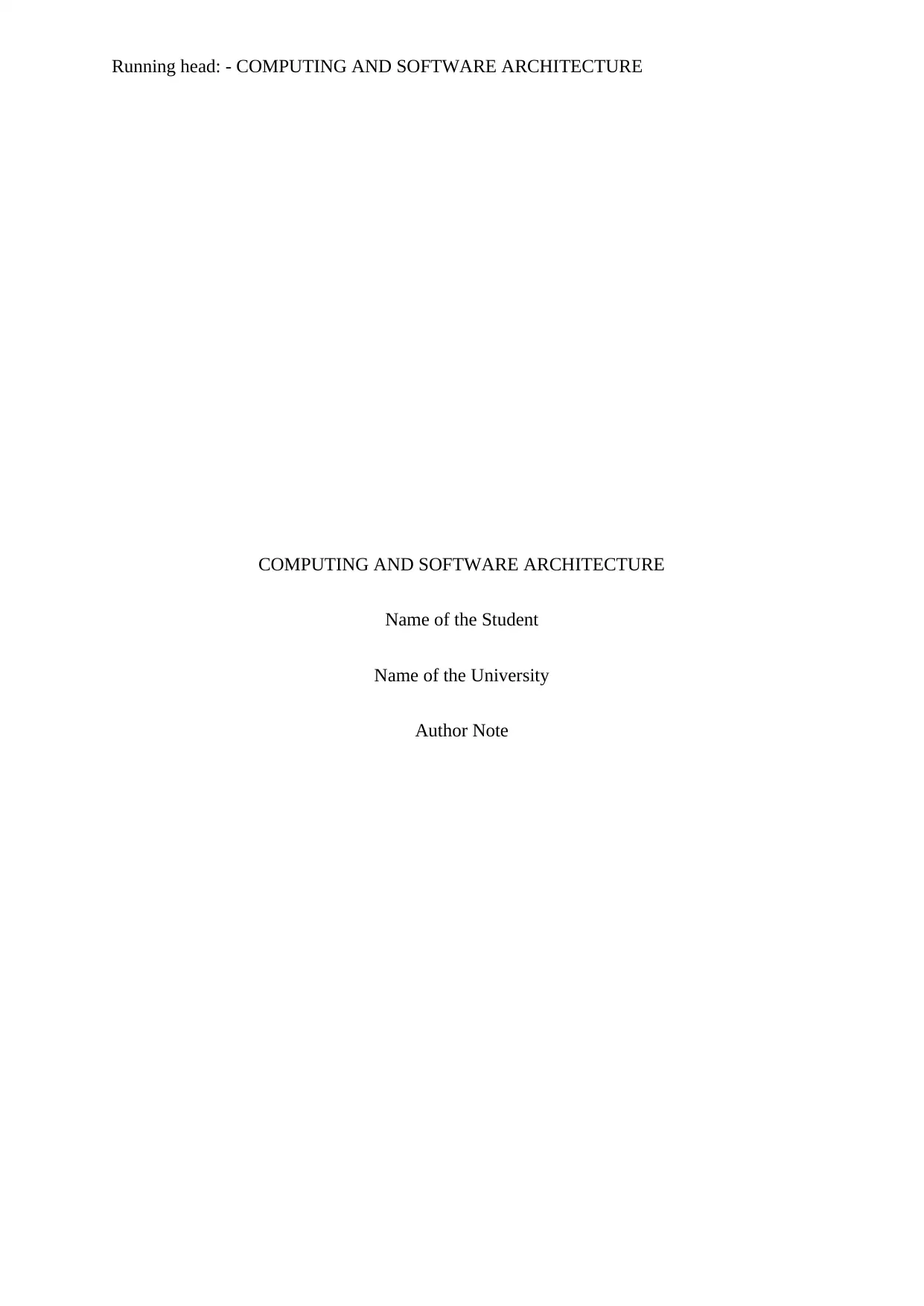
Running head: - COMPUTING AND SOFTWARE ARCHITECTURE
COMPUTING AND SOFTWARE ARCHITECTURE
Name of the Student
Name of the University
Author Note
COMPUTING AND SOFTWARE ARCHITECTURE
Name of the Student
Name of the University
Author Note
Paraphrase This Document
Need a fresh take? Get an instant paraphrase of this document with our AI Paraphraser
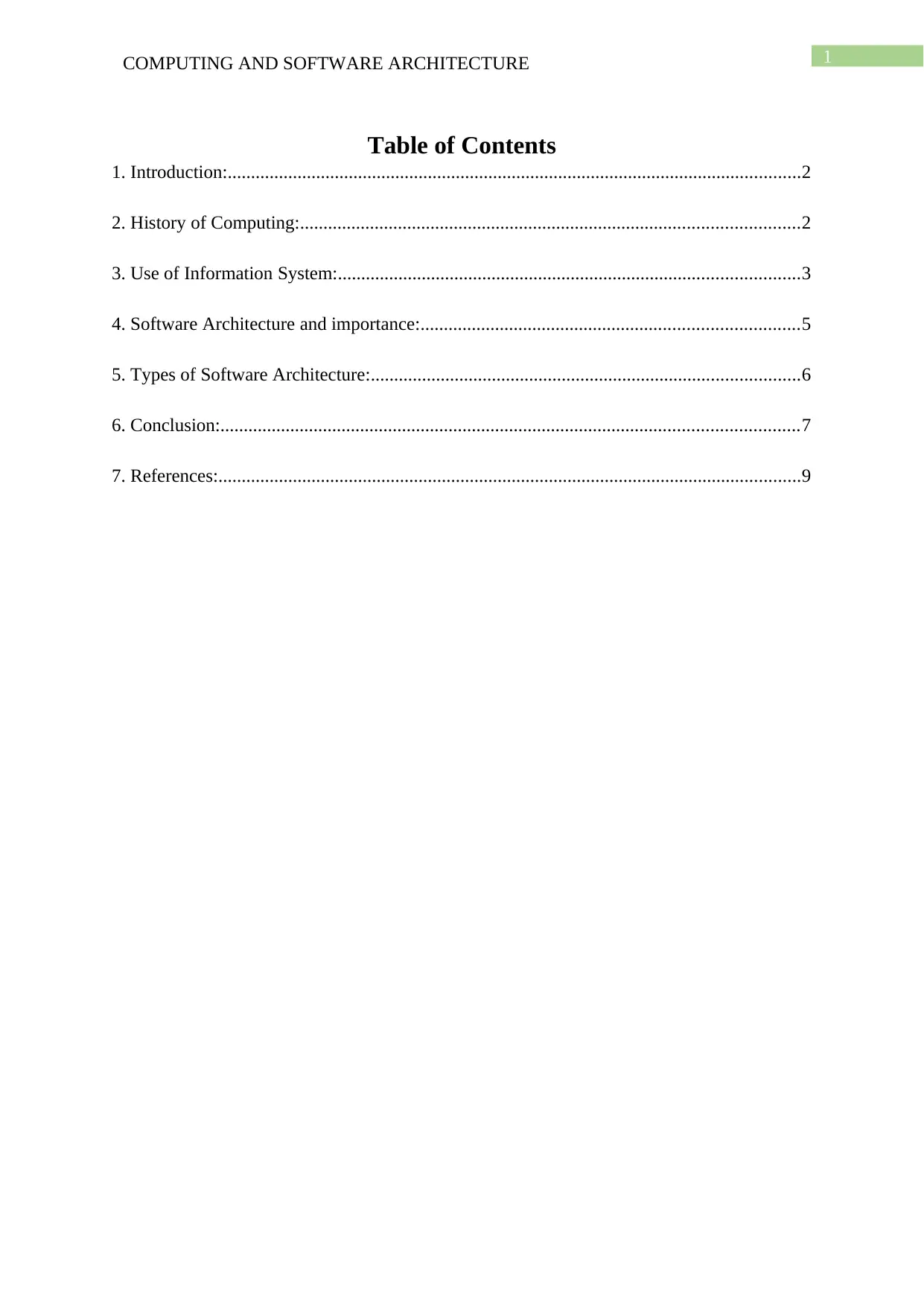
1COMPUTING AND SOFTWARE ARCHITECTURE
Table of Contents
1. Introduction:...........................................................................................................................2
2. History of Computing:...........................................................................................................2
3. Use of Information System:...................................................................................................3
4. Software Architecture and importance:.................................................................................5
5. Types of Software Architecture:............................................................................................6
6. Conclusion:............................................................................................................................7
7. References:.............................................................................................................................9
Table of Contents
1. Introduction:...........................................................................................................................2
2. History of Computing:...........................................................................................................2
3. Use of Information System:...................................................................................................3
4. Software Architecture and importance:.................................................................................5
5. Types of Software Architecture:............................................................................................6
6. Conclusion:............................................................................................................................7
7. References:.............................................................................................................................9
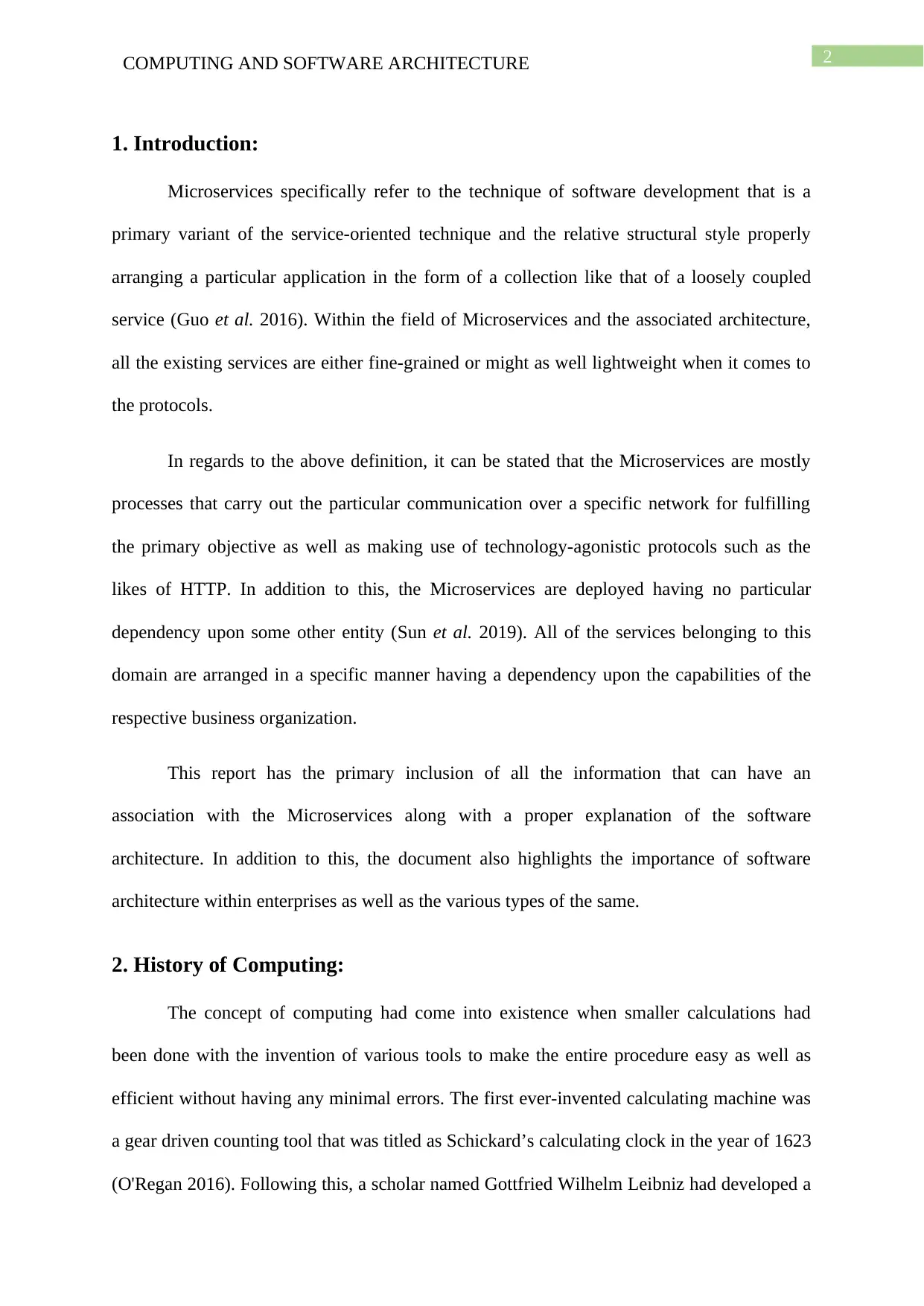
2COMPUTING AND SOFTWARE ARCHITECTURE
1. Introduction:
Microservices specifically refer to the technique of software development that is a
primary variant of the service-oriented technique and the relative structural style properly
arranging a particular application in the form of a collection like that of a loosely coupled
service (Guo et al. 2016). Within the field of Microservices and the associated architecture,
all the existing services are either fine-grained or might as well lightweight when it comes to
the protocols.
In regards to the above definition, it can be stated that the Microservices are mostly
processes that carry out the particular communication over a specific network for fulfilling
the primary objective as well as making use of technology-agonistic protocols such as the
likes of HTTP. In addition to this, the Microservices are deployed having no particular
dependency upon some other entity (Sun et al. 2019). All of the services belonging to this
domain are arranged in a specific manner having a dependency upon the capabilities of the
respective business organization.
This report has the primary inclusion of all the information that can have an
association with the Microservices along with a proper explanation of the software
architecture. In addition to this, the document also highlights the importance of software
architecture within enterprises as well as the various types of the same.
2. History of Computing:
The concept of computing had come into existence when smaller calculations had
been done with the invention of various tools to make the entire procedure easy as well as
efficient without having any minimal errors. The first ever-invented calculating machine was
a gear driven counting tool that was titled as Schickard’s calculating clock in the year of 1623
(O'Regan 2016). Following this, a scholar named Gottfried Wilhelm Leibniz had developed a
1. Introduction:
Microservices specifically refer to the technique of software development that is a
primary variant of the service-oriented technique and the relative structural style properly
arranging a particular application in the form of a collection like that of a loosely coupled
service (Guo et al. 2016). Within the field of Microservices and the associated architecture,
all the existing services are either fine-grained or might as well lightweight when it comes to
the protocols.
In regards to the above definition, it can be stated that the Microservices are mostly
processes that carry out the particular communication over a specific network for fulfilling
the primary objective as well as making use of technology-agonistic protocols such as the
likes of HTTP. In addition to this, the Microservices are deployed having no particular
dependency upon some other entity (Sun et al. 2019). All of the services belonging to this
domain are arranged in a specific manner having a dependency upon the capabilities of the
respective business organization.
This report has the primary inclusion of all the information that can have an
association with the Microservices along with a proper explanation of the software
architecture. In addition to this, the document also highlights the importance of software
architecture within enterprises as well as the various types of the same.
2. History of Computing:
The concept of computing had come into existence when smaller calculations had
been done with the invention of various tools to make the entire procedure easy as well as
efficient without having any minimal errors. The first ever-invented calculating machine was
a gear driven counting tool that was titled as Schickard’s calculating clock in the year of 1623
(O'Regan 2016). Following this, a scholar named Gottfried Wilhelm Leibniz had developed a
⊘ This is a preview!⊘
Do you want full access?
Subscribe today to unlock all pages.

Trusted by 1+ million students worldwide
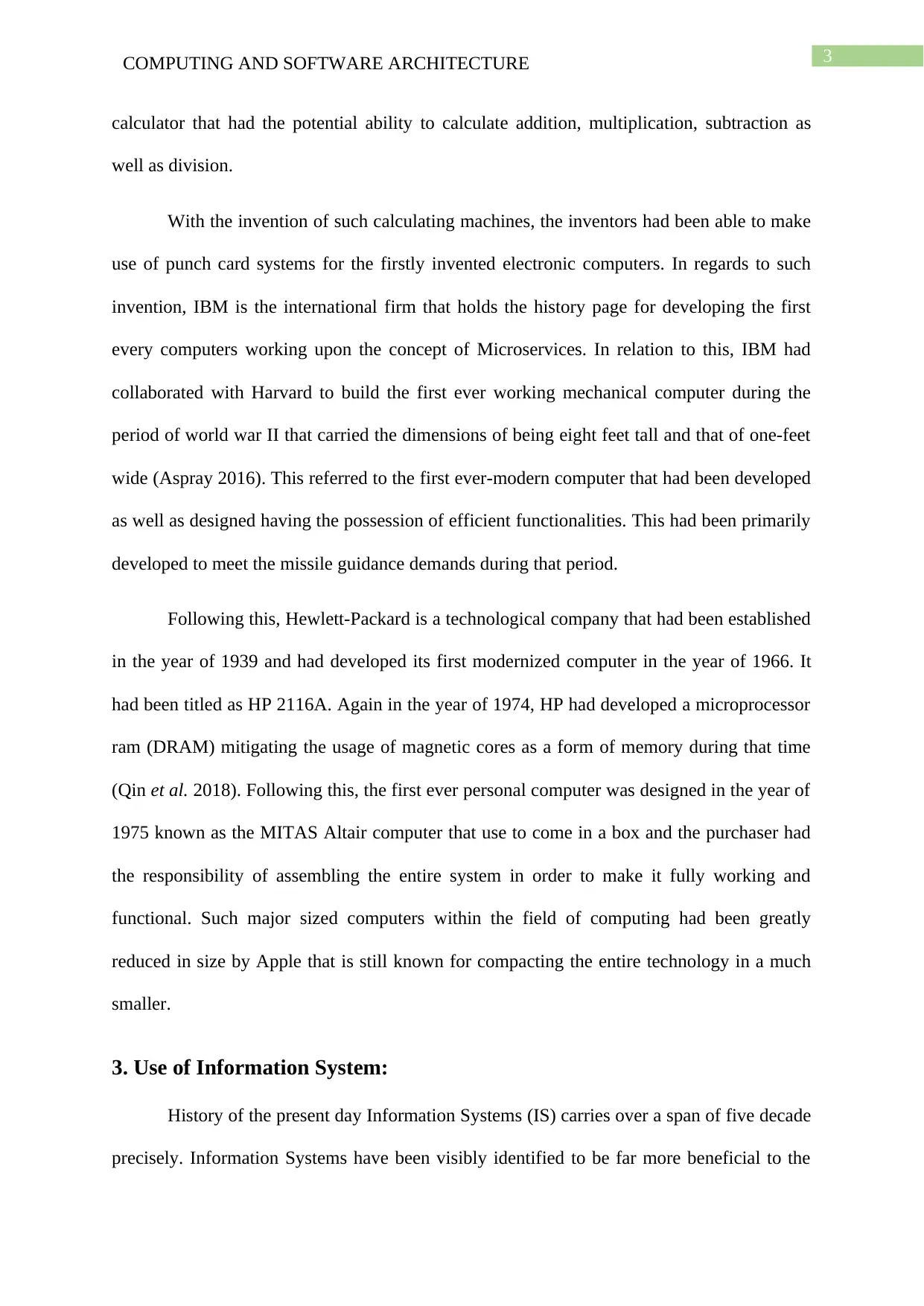
3COMPUTING AND SOFTWARE ARCHITECTURE
calculator that had the potential ability to calculate addition, multiplication, subtraction as
well as division.
With the invention of such calculating machines, the inventors had been able to make
use of punch card systems for the firstly invented electronic computers. In regards to such
invention, IBM is the international firm that holds the history page for developing the first
every computers working upon the concept of Microservices. In relation to this, IBM had
collaborated with Harvard to build the first ever working mechanical computer during the
period of world war II that carried the dimensions of being eight feet tall and that of one-feet
wide (Aspray 2016). This referred to the first ever-modern computer that had been developed
as well as designed having the possession of efficient functionalities. This had been primarily
developed to meet the missile guidance demands during that period.
Following this, Hewlett-Packard is a technological company that had been established
in the year of 1939 and had developed its first modernized computer in the year of 1966. It
had been titled as HP 2116A. Again in the year of 1974, HP had developed a microprocessor
ram (DRAM) mitigating the usage of magnetic cores as a form of memory during that time
(Qin et al. 2018). Following this, the first ever personal computer was designed in the year of
1975 known as the MITAS Altair computer that use to come in a box and the purchaser had
the responsibility of assembling the entire system in order to make it fully working and
functional. Such major sized computers within the field of computing had been greatly
reduced in size by Apple that is still known for compacting the entire technology in a much
smaller.
3. Use of Information System:
History of the present day Information Systems (IS) carries over a span of five decade
precisely. Information Systems have been visibly identified to be far more beneficial to the
calculator that had the potential ability to calculate addition, multiplication, subtraction as
well as division.
With the invention of such calculating machines, the inventors had been able to make
use of punch card systems for the firstly invented electronic computers. In regards to such
invention, IBM is the international firm that holds the history page for developing the first
every computers working upon the concept of Microservices. In relation to this, IBM had
collaborated with Harvard to build the first ever working mechanical computer during the
period of world war II that carried the dimensions of being eight feet tall and that of one-feet
wide (Aspray 2016). This referred to the first ever-modern computer that had been developed
as well as designed having the possession of efficient functionalities. This had been primarily
developed to meet the missile guidance demands during that period.
Following this, Hewlett-Packard is a technological company that had been established
in the year of 1939 and had developed its first modernized computer in the year of 1966. It
had been titled as HP 2116A. Again in the year of 1974, HP had developed a microprocessor
ram (DRAM) mitigating the usage of magnetic cores as a form of memory during that time
(Qin et al. 2018). Following this, the first ever personal computer was designed in the year of
1975 known as the MITAS Altair computer that use to come in a box and the purchaser had
the responsibility of assembling the entire system in order to make it fully working and
functional. Such major sized computers within the field of computing had been greatly
reduced in size by Apple that is still known for compacting the entire technology in a much
smaller.
3. Use of Information System:
History of the present day Information Systems (IS) carries over a span of five decade
precisely. Information Systems have been visibly identified to be far more beneficial to the
Paraphrase This Document
Need a fresh take? Get an instant paraphrase of this document with our AI Paraphraser
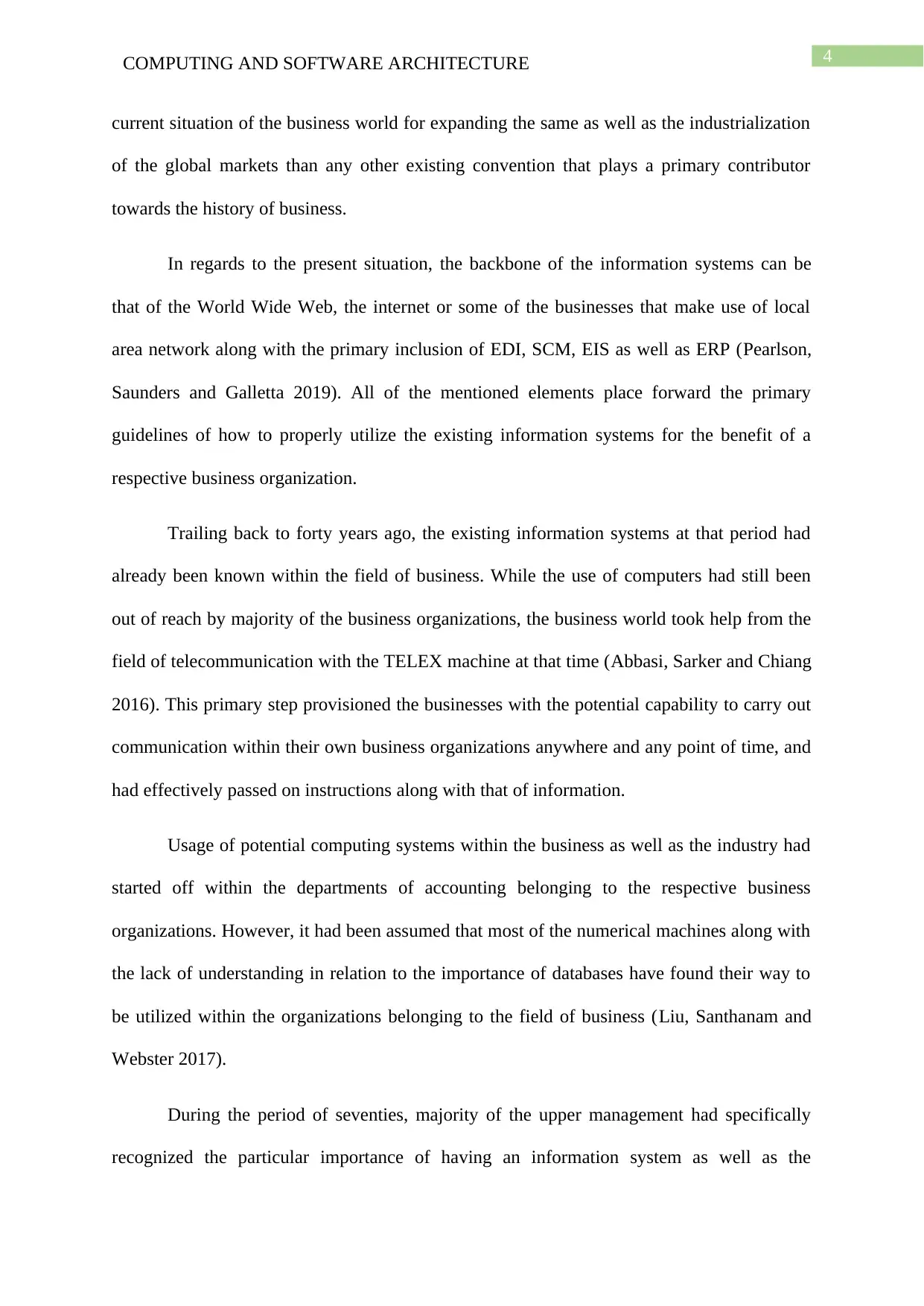
4COMPUTING AND SOFTWARE ARCHITECTURE
current situation of the business world for expanding the same as well as the industrialization
of the global markets than any other existing convention that plays a primary contributor
towards the history of business.
In regards to the present situation, the backbone of the information systems can be
that of the World Wide Web, the internet or some of the businesses that make use of local
area network along with the primary inclusion of EDI, SCM, EIS as well as ERP (Pearlson,
Saunders and Galletta 2019). All of the mentioned elements place forward the primary
guidelines of how to properly utilize the existing information systems for the benefit of a
respective business organization.
Trailing back to forty years ago, the existing information systems at that period had
already been known within the field of business. While the use of computers had still been
out of reach by majority of the business organizations, the business world took help from the
field of telecommunication with the TELEX machine at that time (Abbasi, Sarker and Chiang
2016). This primary step provisioned the businesses with the potential capability to carry out
communication within their own business organizations anywhere and any point of time, and
had effectively passed on instructions along with that of information.
Usage of potential computing systems within the business as well as the industry had
started off within the departments of accounting belonging to the respective business
organizations. However, it had been assumed that most of the numerical machines along with
the lack of understanding in relation to the importance of databases have found their way to
be utilized within the organizations belonging to the field of business (Liu, Santhanam and
Webster 2017).
During the period of seventies, majority of the upper management had specifically
recognized the particular importance of having an information system as well as the
current situation of the business world for expanding the same as well as the industrialization
of the global markets than any other existing convention that plays a primary contributor
towards the history of business.
In regards to the present situation, the backbone of the information systems can be
that of the World Wide Web, the internet or some of the businesses that make use of local
area network along with the primary inclusion of EDI, SCM, EIS as well as ERP (Pearlson,
Saunders and Galletta 2019). All of the mentioned elements place forward the primary
guidelines of how to properly utilize the existing information systems for the benefit of a
respective business organization.
Trailing back to forty years ago, the existing information systems at that period had
already been known within the field of business. While the use of computers had still been
out of reach by majority of the business organizations, the business world took help from the
field of telecommunication with the TELEX machine at that time (Abbasi, Sarker and Chiang
2016). This primary step provisioned the businesses with the potential capability to carry out
communication within their own business organizations anywhere and any point of time, and
had effectively passed on instructions along with that of information.
Usage of potential computing systems within the business as well as the industry had
started off within the departments of accounting belonging to the respective business
organizations. However, it had been assumed that most of the numerical machines along with
the lack of understanding in relation to the importance of databases have found their way to
be utilized within the organizations belonging to the field of business (Liu, Santhanam and
Webster 2017).
During the period of seventies, majority of the upper management had specifically
recognized the particular importance of having an information system as well as the
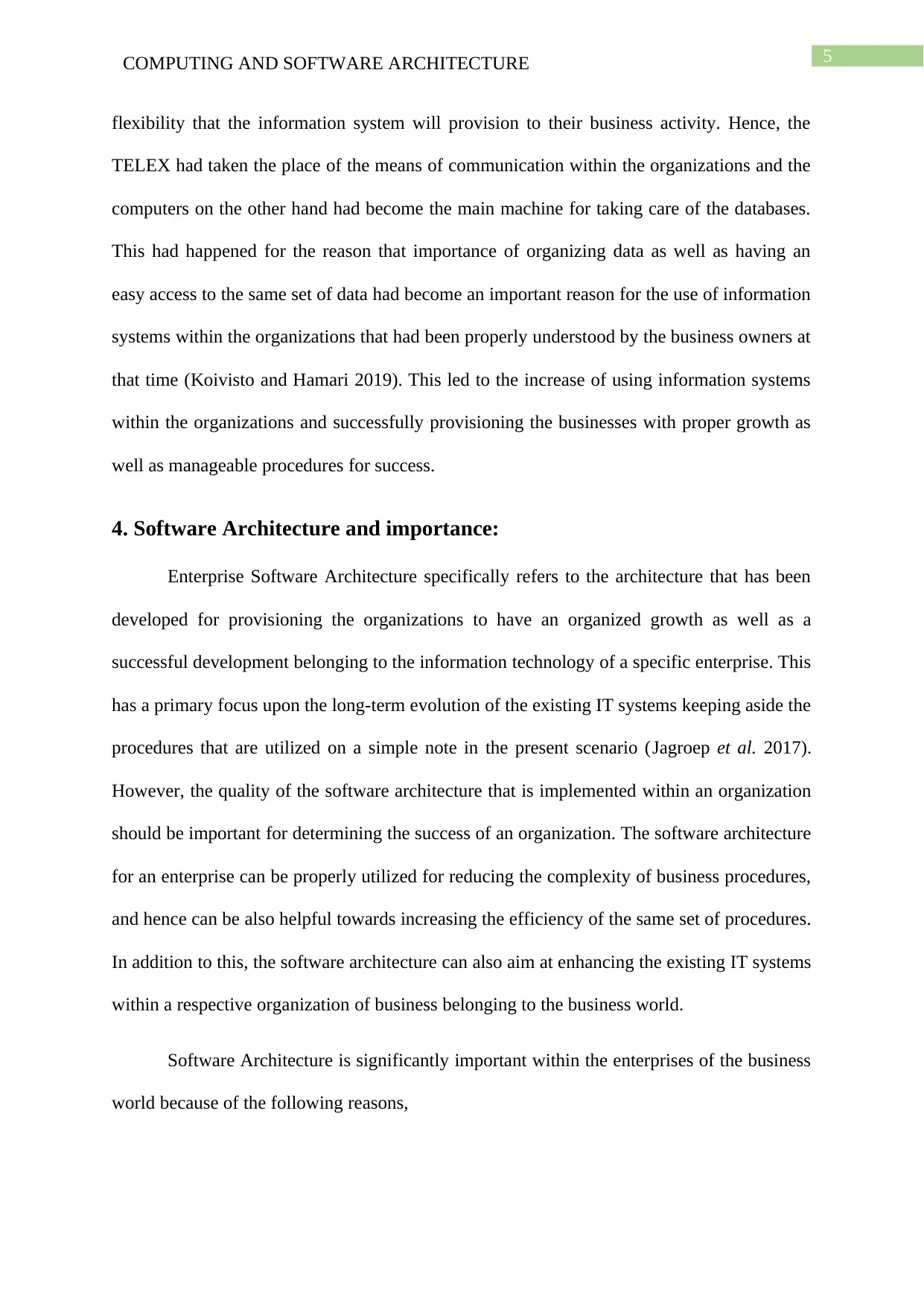
5COMPUTING AND SOFTWARE ARCHITECTURE
flexibility that the information system will provision to their business activity. Hence, the
TELEX had taken the place of the means of communication within the organizations and the
computers on the other hand had become the main machine for taking care of the databases.
This had happened for the reason that importance of organizing data as well as having an
easy access to the same set of data had become an important reason for the use of information
systems within the organizations that had been properly understood by the business owners at
that time (Koivisto and Hamari 2019). This led to the increase of using information systems
within the organizations and successfully provisioning the businesses with proper growth as
well as manageable procedures for success.
4. Software Architecture and importance:
Enterprise Software Architecture specifically refers to the architecture that has been
developed for provisioning the organizations to have an organized growth as well as a
successful development belonging to the information technology of a specific enterprise. This
has a primary focus upon the long-term evolution of the existing IT systems keeping aside the
procedures that are utilized on a simple note in the present scenario (Jagroep et al. 2017).
However, the quality of the software architecture that is implemented within an organization
should be important for determining the success of an organization. The software architecture
for an enterprise can be properly utilized for reducing the complexity of business procedures,
and hence can be also helpful towards increasing the efficiency of the same set of procedures.
In addition to this, the software architecture can also aim at enhancing the existing IT systems
within a respective organization of business belonging to the business world.
Software Architecture is significantly important within the enterprises of the business
world because of the following reasons,
flexibility that the information system will provision to their business activity. Hence, the
TELEX had taken the place of the means of communication within the organizations and the
computers on the other hand had become the main machine for taking care of the databases.
This had happened for the reason that importance of organizing data as well as having an
easy access to the same set of data had become an important reason for the use of information
systems within the organizations that had been properly understood by the business owners at
that time (Koivisto and Hamari 2019). This led to the increase of using information systems
within the organizations and successfully provisioning the businesses with proper growth as
well as manageable procedures for success.
4. Software Architecture and importance:
Enterprise Software Architecture specifically refers to the architecture that has been
developed for provisioning the organizations to have an organized growth as well as a
successful development belonging to the information technology of a specific enterprise. This
has a primary focus upon the long-term evolution of the existing IT systems keeping aside the
procedures that are utilized on a simple note in the present scenario (Jagroep et al. 2017).
However, the quality of the software architecture that is implemented within an organization
should be important for determining the success of an organization. The software architecture
for an enterprise can be properly utilized for reducing the complexity of business procedures,
and hence can be also helpful towards increasing the efficiency of the same set of procedures.
In addition to this, the software architecture can also aim at enhancing the existing IT systems
within a respective organization of business belonging to the business world.
Software Architecture is significantly important within the enterprises of the business
world because of the following reasons,
⊘ This is a preview!⊘
Do you want full access?
Subscribe today to unlock all pages.

Trusted by 1+ million students worldwide
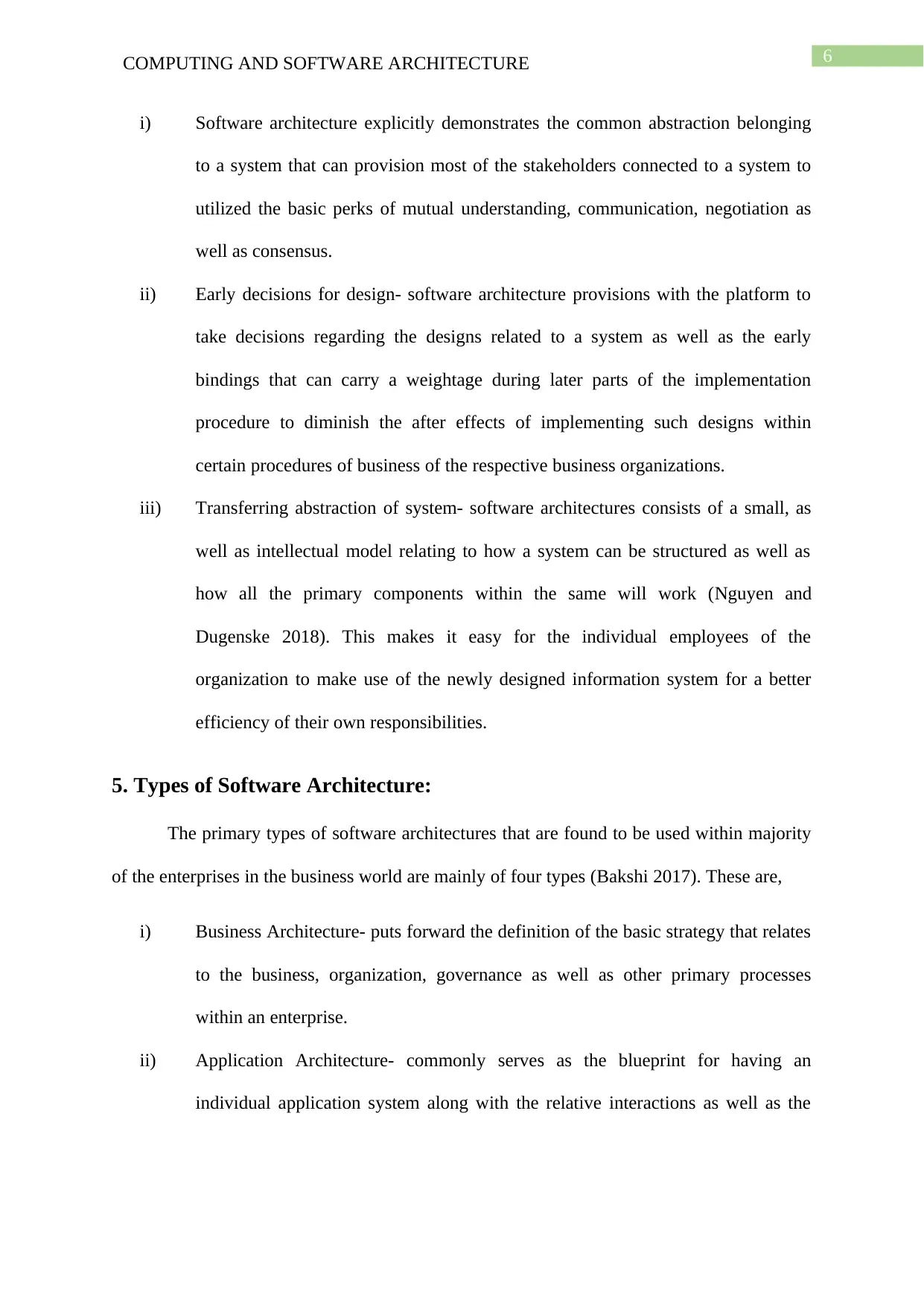
6COMPUTING AND SOFTWARE ARCHITECTURE
i) Software architecture explicitly demonstrates the common abstraction belonging
to a system that can provision most of the stakeholders connected to a system to
utilized the basic perks of mutual understanding, communication, negotiation as
well as consensus.
ii) Early decisions for design- software architecture provisions with the platform to
take decisions regarding the designs related to a system as well as the early
bindings that can carry a weightage during later parts of the implementation
procedure to diminish the after effects of implementing such designs within
certain procedures of business of the respective business organizations.
iii) Transferring abstraction of system- software architectures consists of a small, as
well as intellectual model relating to how a system can be structured as well as
how all the primary components within the same will work (Nguyen and
Dugenske 2018). This makes it easy for the individual employees of the
organization to make use of the newly designed information system for a better
efficiency of their own responsibilities.
5. Types of Software Architecture:
The primary types of software architectures that are found to be used within majority
of the enterprises in the business world are mainly of four types (Bakshi 2017). These are,
i) Business Architecture- puts forward the definition of the basic strategy that relates
to the business, organization, governance as well as other primary processes
within an enterprise.
ii) Application Architecture- commonly serves as the blueprint for having an
individual application system along with the relative interactions as well as the
i) Software architecture explicitly demonstrates the common abstraction belonging
to a system that can provision most of the stakeholders connected to a system to
utilized the basic perks of mutual understanding, communication, negotiation as
well as consensus.
ii) Early decisions for design- software architecture provisions with the platform to
take decisions regarding the designs related to a system as well as the early
bindings that can carry a weightage during later parts of the implementation
procedure to diminish the after effects of implementing such designs within
certain procedures of business of the respective business organizations.
iii) Transferring abstraction of system- software architectures consists of a small, as
well as intellectual model relating to how a system can be structured as well as
how all the primary components within the same will work (Nguyen and
Dugenske 2018). This makes it easy for the individual employees of the
organization to make use of the newly designed information system for a better
efficiency of their own responsibilities.
5. Types of Software Architecture:
The primary types of software architectures that are found to be used within majority
of the enterprises in the business world are mainly of four types (Bakshi 2017). These are,
i) Business Architecture- puts forward the definition of the basic strategy that relates
to the business, organization, governance as well as other primary processes
within an enterprise.
ii) Application Architecture- commonly serves as the blueprint for having an
individual application system along with the relative interactions as well as the
Paraphrase This Document
Need a fresh take? Get an instant paraphrase of this document with our AI Paraphraser
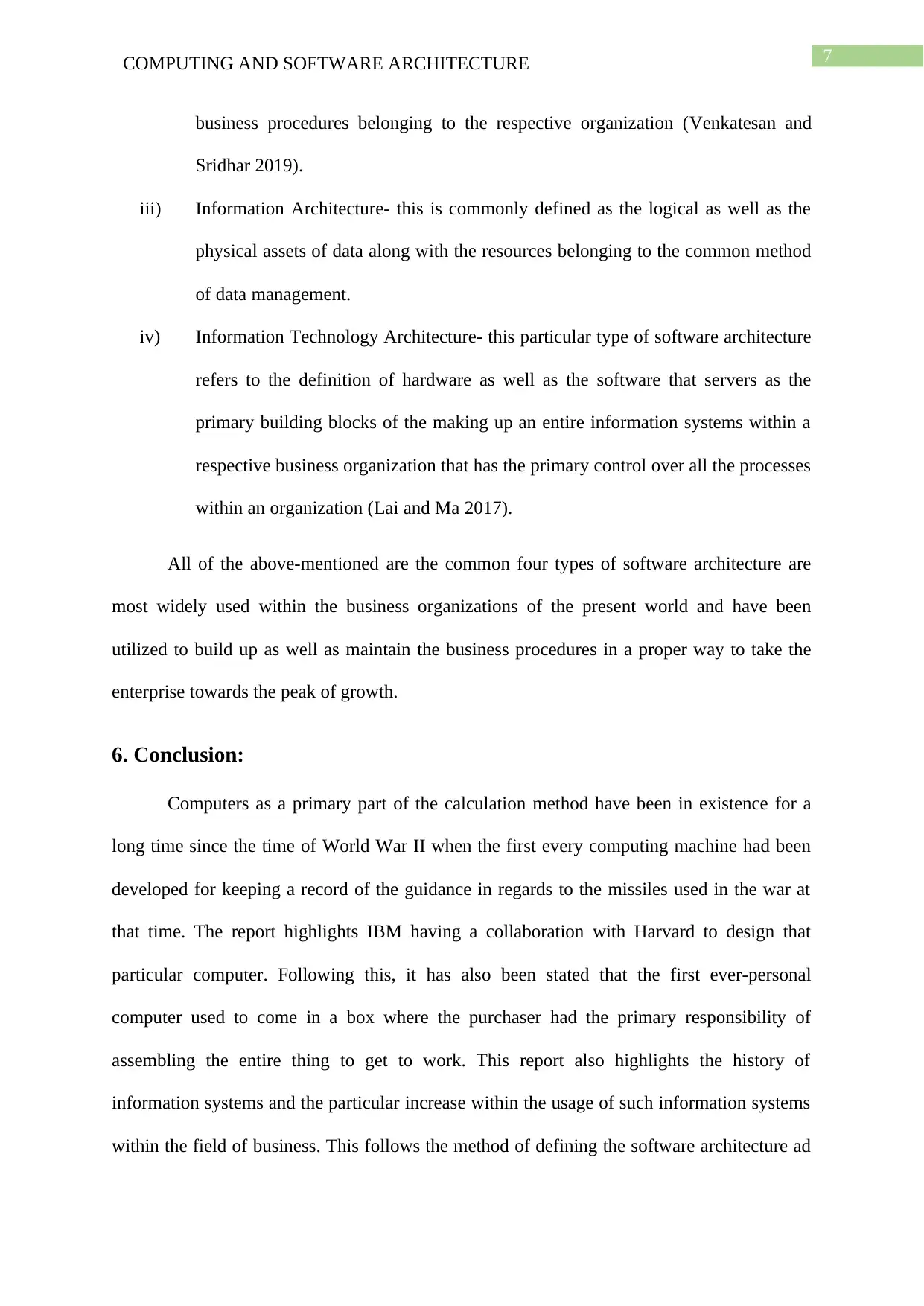
7COMPUTING AND SOFTWARE ARCHITECTURE
business procedures belonging to the respective organization (Venkatesan and
Sridhar 2019).
iii) Information Architecture- this is commonly defined as the logical as well as the
physical assets of data along with the resources belonging to the common method
of data management.
iv) Information Technology Architecture- this particular type of software architecture
refers to the definition of hardware as well as the software that servers as the
primary building blocks of the making up an entire information systems within a
respective business organization that has the primary control over all the processes
within an organization (Lai and Ma 2017).
All of the above-mentioned are the common four types of software architecture are
most widely used within the business organizations of the present world and have been
utilized to build up as well as maintain the business procedures in a proper way to take the
enterprise towards the peak of growth.
6. Conclusion:
Computers as a primary part of the calculation method have been in existence for a
long time since the time of World War II when the first every computing machine had been
developed for keeping a record of the guidance in regards to the missiles used in the war at
that time. The report highlights IBM having a collaboration with Harvard to design that
particular computer. Following this, it has also been stated that the first ever-personal
computer used to come in a box where the purchaser had the primary responsibility of
assembling the entire thing to get to work. This report also highlights the history of
information systems and the particular increase within the usage of such information systems
within the field of business. This follows the method of defining the software architecture ad
business procedures belonging to the respective organization (Venkatesan and
Sridhar 2019).
iii) Information Architecture- this is commonly defined as the logical as well as the
physical assets of data along with the resources belonging to the common method
of data management.
iv) Information Technology Architecture- this particular type of software architecture
refers to the definition of hardware as well as the software that servers as the
primary building blocks of the making up an entire information systems within a
respective business organization that has the primary control over all the processes
within an organization (Lai and Ma 2017).
All of the above-mentioned are the common four types of software architecture are
most widely used within the business organizations of the present world and have been
utilized to build up as well as maintain the business procedures in a proper way to take the
enterprise towards the peak of growth.
6. Conclusion:
Computers as a primary part of the calculation method have been in existence for a
long time since the time of World War II when the first every computing machine had been
developed for keeping a record of the guidance in regards to the missiles used in the war at
that time. The report highlights IBM having a collaboration with Harvard to design that
particular computer. Following this, it has also been stated that the first ever-personal
computer used to come in a box where the purchaser had the primary responsibility of
assembling the entire thing to get to work. This report also highlights the history of
information systems and the particular increase within the usage of such information systems
within the field of business. This follows the method of defining the software architecture ad

8COMPUTING AND SOFTWARE ARCHITECTURE
how it has helped towards designing the information systems within the majority of the
enterprises that make use of the same. In addition to this, in the above stated discussion it has
also been stated that there is the shared existence of four common types of software
architectures among which, the information technology architecture is the most widely
utilized one for the characteristics of the system that has been highlighted additionally.
how it has helped towards designing the information systems within the majority of the
enterprises that make use of the same. In addition to this, in the above stated discussion it has
also been stated that there is the shared existence of four common types of software
architectures among which, the information technology architecture is the most widely
utilized one for the characteristics of the system that has been highlighted additionally.
⊘ This is a preview!⊘
Do you want full access?
Subscribe today to unlock all pages.

Trusted by 1+ million students worldwide
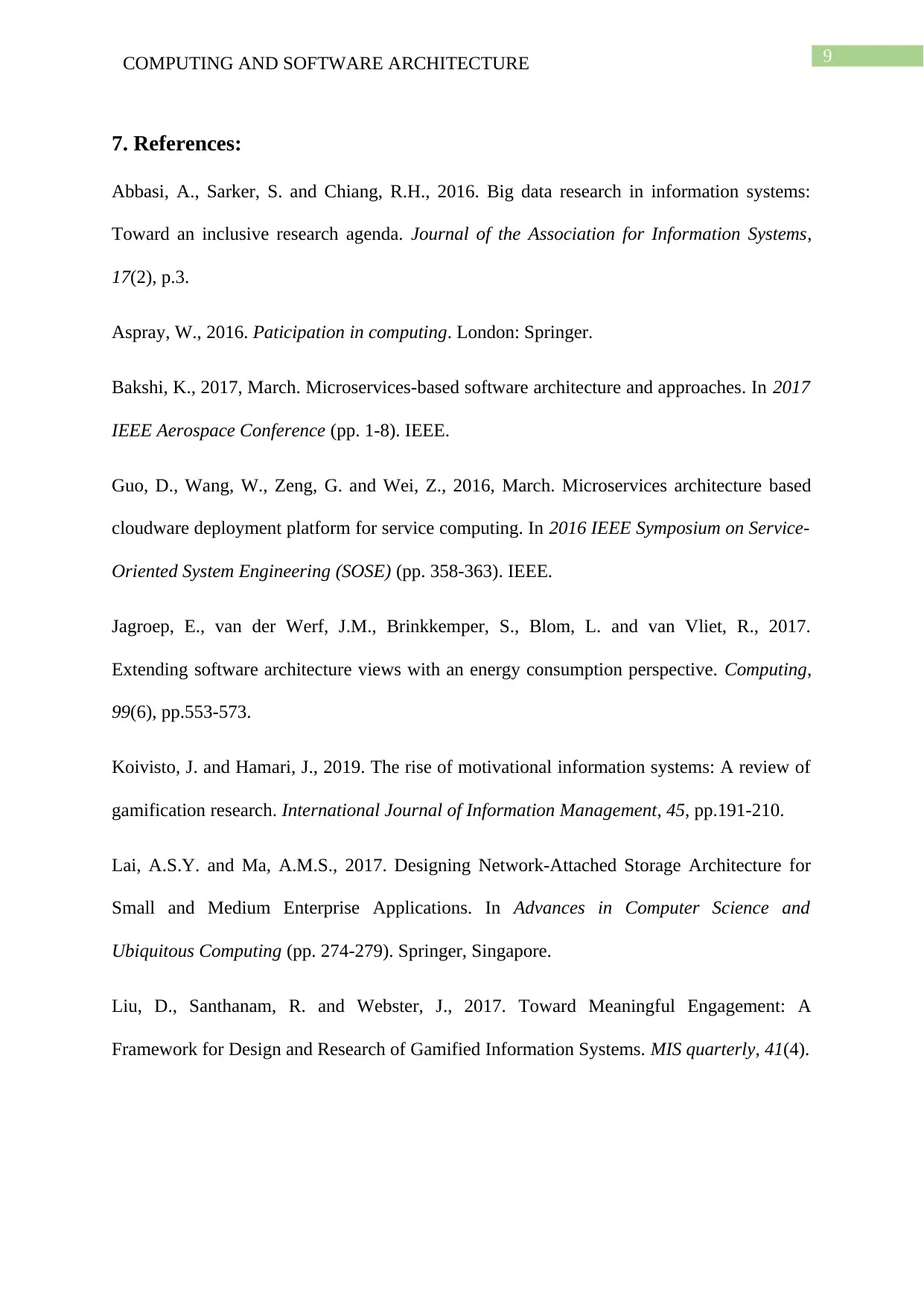
9COMPUTING AND SOFTWARE ARCHITECTURE
7. References:
Abbasi, A., Sarker, S. and Chiang, R.H., 2016. Big data research in information systems:
Toward an inclusive research agenda. Journal of the Association for Information Systems,
17(2), p.3.
Aspray, W., 2016. Paticipation in computing. London: Springer.
Bakshi, K., 2017, March. Microservices-based software architecture and approaches. In 2017
IEEE Aerospace Conference (pp. 1-8). IEEE.
Guo, D., Wang, W., Zeng, G. and Wei, Z., 2016, March. Microservices architecture based
cloudware deployment platform for service computing. In 2016 IEEE Symposium on Service-
Oriented System Engineering (SOSE) (pp. 358-363). IEEE.
Jagroep, E., van der Werf, J.M., Brinkkemper, S., Blom, L. and van Vliet, R., 2017.
Extending software architecture views with an energy consumption perspective. Computing,
99(6), pp.553-573.
Koivisto, J. and Hamari, J., 2019. The rise of motivational information systems: A review of
gamification research. International Journal of Information Management, 45, pp.191-210.
Lai, A.S.Y. and Ma, A.M.S., 2017. Designing Network-Attached Storage Architecture for
Small and Medium Enterprise Applications. In Advances in Computer Science and
Ubiquitous Computing (pp. 274-279). Springer, Singapore.
Liu, D., Santhanam, R. and Webster, J., 2017. Toward Meaningful Engagement: A
Framework for Design and Research of Gamified Information Systems. MIS quarterly, 41(4).
7. References:
Abbasi, A., Sarker, S. and Chiang, R.H., 2016. Big data research in information systems:
Toward an inclusive research agenda. Journal of the Association for Information Systems,
17(2), p.3.
Aspray, W., 2016. Paticipation in computing. London: Springer.
Bakshi, K., 2017, March. Microservices-based software architecture and approaches. In 2017
IEEE Aerospace Conference (pp. 1-8). IEEE.
Guo, D., Wang, W., Zeng, G. and Wei, Z., 2016, March. Microservices architecture based
cloudware deployment platform for service computing. In 2016 IEEE Symposium on Service-
Oriented System Engineering (SOSE) (pp. 358-363). IEEE.
Jagroep, E., van der Werf, J.M., Brinkkemper, S., Blom, L. and van Vliet, R., 2017.
Extending software architecture views with an energy consumption perspective. Computing,
99(6), pp.553-573.
Koivisto, J. and Hamari, J., 2019. The rise of motivational information systems: A review of
gamification research. International Journal of Information Management, 45, pp.191-210.
Lai, A.S.Y. and Ma, A.M.S., 2017. Designing Network-Attached Storage Architecture for
Small and Medium Enterprise Applications. In Advances in Computer Science and
Ubiquitous Computing (pp. 274-279). Springer, Singapore.
Liu, D., Santhanam, R. and Webster, J., 2017. Toward Meaningful Engagement: A
Framework for Design and Research of Gamified Information Systems. MIS quarterly, 41(4).
Paraphrase This Document
Need a fresh take? Get an instant paraphrase of this document with our AI Paraphraser
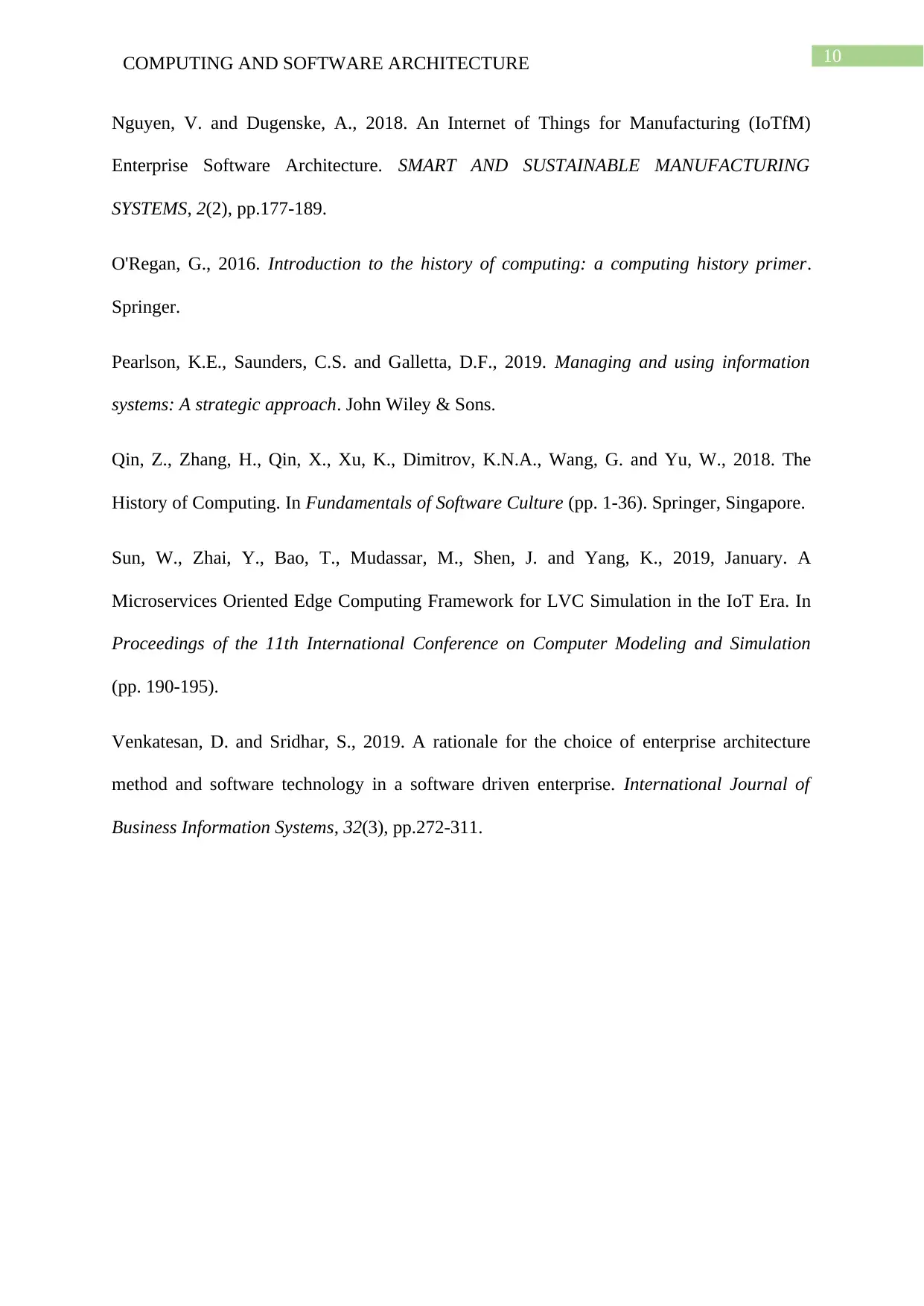
10COMPUTING AND SOFTWARE ARCHITECTURE
Nguyen, V. and Dugenske, A., 2018. An Internet of Things for Manufacturing (IoTfM)
Enterprise Software Architecture. SMART AND SUSTAINABLE MANUFACTURING
SYSTEMS, 2(2), pp.177-189.
O'Regan, G., 2016. Introduction to the history of computing: a computing history primer.
Springer.
Pearlson, K.E., Saunders, C.S. and Galletta, D.F., 2019. Managing and using information
systems: A strategic approach. John Wiley & Sons.
Qin, Z., Zhang, H., Qin, X., Xu, K., Dimitrov, K.N.A., Wang, G. and Yu, W., 2018. The
History of Computing. In Fundamentals of Software Culture (pp. 1-36). Springer, Singapore.
Sun, W., Zhai, Y., Bao, T., Mudassar, M., Shen, J. and Yang, K., 2019, January. A
Microservices Oriented Edge Computing Framework for LVC Simulation in the IoT Era. In
Proceedings of the 11th International Conference on Computer Modeling and Simulation
(pp. 190-195).
Venkatesan, D. and Sridhar, S., 2019. A rationale for the choice of enterprise architecture
method and software technology in a software driven enterprise. International Journal of
Business Information Systems, 32(3), pp.272-311.
Nguyen, V. and Dugenske, A., 2018. An Internet of Things for Manufacturing (IoTfM)
Enterprise Software Architecture. SMART AND SUSTAINABLE MANUFACTURING
SYSTEMS, 2(2), pp.177-189.
O'Regan, G., 2016. Introduction to the history of computing: a computing history primer.
Springer.
Pearlson, K.E., Saunders, C.S. and Galletta, D.F., 2019. Managing and using information
systems: A strategic approach. John Wiley & Sons.
Qin, Z., Zhang, H., Qin, X., Xu, K., Dimitrov, K.N.A., Wang, G. and Yu, W., 2018. The
History of Computing. In Fundamentals of Software Culture (pp. 1-36). Springer, Singapore.
Sun, W., Zhai, Y., Bao, T., Mudassar, M., Shen, J. and Yang, K., 2019, January. A
Microservices Oriented Edge Computing Framework for LVC Simulation in the IoT Era. In
Proceedings of the 11th International Conference on Computer Modeling and Simulation
(pp. 190-195).
Venkatesan, D. and Sridhar, S., 2019. A rationale for the choice of enterprise architecture
method and software technology in a software driven enterprise. International Journal of
Business Information Systems, 32(3), pp.272-311.
1 out of 11
Related Documents
Your All-in-One AI-Powered Toolkit for Academic Success.
+13062052269
info@desklib.com
Available 24*7 on WhatsApp / Email
![[object Object]](/_next/static/media/star-bottom.7253800d.svg)
Unlock your academic potential
Copyright © 2020–2025 A2Z Services. All Rights Reserved. Developed and managed by ZUCOL.





